Flexible Actuators Based on Conductive Polymer Ionogels and Their Electromechanical Modeling
Abstract
:1. Introduction
2. Experimental and Simulation Method
2.1. Design and Operating Principle
2.2. Materials
2.3. Fabrication of Flexible Actuator Based on the CP Ionogel
2.4. Characterization and Measurement
2.5. Simulation Method
- Since the surface resistance of electrodes is very small ( 14 ), it is assumed that the resistances in each stage of the RC circuit are equal: .
- Since the thickness of the capacitor layer is very small (0.14 mm), the micro-element capacity of the capacitor in the radial direction is equal.
- The bending of the actuator is uniform along the whole beam.
- The influence of bending on the electrical properties of the capacitor layer is negligible.
- The driving force comes from the ionogel electrode layer with a uniform stress distribution.
3. Results and Discussion
3.1. Driving Characteristics of the Flexible Actuator
3.2. Modeling
3.3. Parameter Identification and Verification
3.4. Analysis Result
4. Conclusions
Author Contributions
Funding
Institutional Review Board Statement
Data Availability Statement
Conflicts of Interest
References
- Li, M.; Pal, A.; Aghakhani, A.; Pena-Francesch, A.; Sitti, M. Soft actuators for real-world applications. Nat. Rev. Mater. 2022, 7, 235–249. [Google Scholar] [CrossRef]
- Apsite, I.; Salehi, S.; Ionov, L. Materials for smart soft actuator systems. Chem. Rev. 2021, 122, 1349–1415. [Google Scholar] [CrossRef]
- Hao, Y.; Zhang, S.; Fang, B.; Sun, F.; Liu, H.; Li, H. A review of smart materials for the boost of soft actuators, soft sensors, and robotics applications. Chin. J. Mech. Eng. 2022, 35, 37. [Google Scholar] [CrossRef]
- Kim, O.; Kim, S.J.; Park, M.J. Low-voltage-driven soft actuators. Chem. Commun. 2018, 54, 4895–4904. [Google Scholar] [CrossRef]
- Wang, H.S.; Cho, J.; Song, D.S.; Jang, J.H.; Jho, J.Y.; Park, J.H. High-performance electroactive polymer actuators based on ultrathick ionic polymer–metal composites with nanodispersed metal electrodes. ACS Appl. Mater. Interfaces 2017, 9, 21998–22005. [Google Scholar] [CrossRef]
- Jo, C.; Pugal, D.; Oh, I.K.; Kim, K.J.; Asaka, K. Recent advances in ionic polymer–metal composite actuators and their modeling and applications. Prog. Polym. Sci. 2013, 38, 1037–1066. [Google Scholar] [CrossRef]
- Fukushima, T.; Asaka, K.; Kosaka, A.; Aida, T. Fully plastic actuator through layer-by-layer casting with ionic-liquid-based bucky gel. Angew. Chem. 2005, 117, 2462–2465. [Google Scholar] [CrossRef]
- Mukai, K.; Asaka, K.; Sugino, T.; Kiyohara, K.; Takeuchi, I.; Terasawa, N.; Futaba, D.N.; Hata, K.; Fukushima, T.; Aida, T. Highly conductive sheets from millimeter-long single-walled carbon nanotubes and ionic liquids: Application to fast-moving, low-voltage electromechanical actuators operable in air. Adv. Mater. 2009, 21, 1582–1585. [Google Scholar] [CrossRef]
- Lu, C.; Yang, Y.; Wang, J.; Fu, R.; Zhao, X.; Zhao, L.; Ming, Y.; Hu, Y.; Lin, H.; Tao, X.; et al. High-performance graphdiyne-based electrochemical actuators. Nat. Commun. 2018, 9, 752. [Google Scholar] [CrossRef]
- Umrao, S.; Tabassian, R.; Kim, J.; Nguyen, V.H.; Zhou, Q.; Nam, S.; Oh, I.K. MXene artificial muscles based on ionically cross-linked Ti3C2T x electrode for kinetic soft robotics. Sci. Robot. 2019, 4, eaaw7797. [Google Scholar] [CrossRef]
- Wu, G.; Hu, Y.; Liu, Y.; Zhao, J.; Chen, X.; Whoehling, V.; Plesse, C.; Nguyen, G.T.; Vidal, F.; Chen, W. Graphitic carbon nitride nanosheet electrode-based high-performance ionic actuator. Nat. Commun. 2015, 6, 7258. [Google Scholar] [CrossRef] [PubMed]
- Spinks, G.M.; Wallace, G.G.; Liu, L.; Zhou, D. Conducting polymers electromechanical actuators and strain sensors. Macromol. Symp. 2003, 192, 161–170. [Google Scholar] [CrossRef]
- Malinauskas, A.; Malinauskiene, J.; Ramanavičius, A. Conducting polymer-based nanostructurized materials: Electrochemical aspects. Nanotechnology 2005, 16, R51. [Google Scholar] [CrossRef]
- Li, L.; Xu, J.; Li, Q.; Jiang, Y.; Dong, X.; Ding, J. Small Multi-Attitude Soft Amphibious Robot. IEEE Robot. Autom. Lett. 2023, 1–8. [Google Scholar] [CrossRef]
- Jiang, Y.; Dong, X.; Wang, Q.; Dai, S.; Li, L.; Yuan, N.; Ding, J. A High-Fidelity Preparation Method for Liquid Crystal Elastomer Actuators. Langmuir 2022, 38, 7190–7197. [Google Scholar] [CrossRef] [PubMed]
- Wang, Z.; He, B.; Liu, X.; Wang, Q. Development and modeling of a new ionogel based actuator. J. Intell. Mater. Syst. Struct. 2017, 28, 2036–2050. [Google Scholar] [CrossRef]
- Wang, Y.; Zhu, C.; Pfattner, R.; Yan, H.; Jin, L.; Chen, S.; Molina-Lopez, F.; Lissel, F.; Liu, J.; Rabiah, N.I.; et al. A highly stretchable, transparent, and conductive polymer. Sci. Adv. 2017, 3, e1602076. [Google Scholar] [CrossRef]
- Petroffe, G.; Beouch, L.; Cantin, S.; Aubert, P.H.; Plesse, C.; Dudon, J.P.; Vidal, F.; Chevrot, C. Investigations of ionic liquids on the infrared electroreflective properties of poly (3, 4-ethylenedioxythiophene). Sol. Energy Mater. Sol. Cells 2018, 177, 23–31. [Google Scholar] [CrossRef]
- Lee, J.W.; Yu, S.; Hong, S.M.; Koo, C.M. High-strain air-working soft transducers produced from nanostructured block copolymer ionomer/silicate/ionic liquid nanocomposite membranes. J. Mater. Chem. C 2013, 1, 3784–3793. [Google Scholar] [CrossRef]
- Imaizumi, S.; Kokubo, H.; Watanabe, M. Polymer actuators using ion-gel electrolytes prepared by self-assembly of ABA-triblock copolymers. Macromolecules 2012, 45, 401–409. [Google Scholar] [CrossRef]
- Kim, O.; Kim, S.Y.; Park, B.; Hwang, W.; Park, M.J. Factors affecting electromechanical properties of ionic polymer actuators based on ionic liquid-containing sulfonated block copolymers. Macromolecules 2014, 47, 4357–4368. [Google Scholar] [CrossRef]
- Lee, J.W.; Yoo, Y.T.; Lee, J.Y. Ionic polymer–metal composite actuators based on triple-layered polyelectrolytes composed of individually functionalized layers. ACS Appl. Mater. Interfaces 2014, 6, 1266–1271. [Google Scholar] [CrossRef] [PubMed]
- Rohtlaid, K.; Nguyen, G.T.; Soyer, C.; Cattan, E.; Vidal, F.; Plesse, C. Poly (3, 4-ethylenedioxythiophene): Poly (styrene sulfonate)/polyethylene oxide electrodes with improved electrical and electrochemical properties for soft microactuators and microsensors. Adv. Electron. Mater. 2019, 5, 1800948. [Google Scholar] [CrossRef]
- Terasawa, N.; Asaka, K. High-performance PEDOT: PSS/single-walled carbon nanotube/ionic liquid actuators combining electrostatic double-layer and faradaic capacitors. Langmuir 2016, 32, 7210–7218. [Google Scholar] [CrossRef]
- Terasawa, N.; Asaka, K. Self-standing cellulose nanofiber/poly (3, 4-ethylenedioxythiophene): Poly (4-styrenesulfonate)/ionic liquid actuators with superior performance. RSC Adv. 2018, 8, 33149–33155. [Google Scholar] [CrossRef] [PubMed]
- Terasawa, N.; Asaka, K. Performance enhancement of PEDOT: Poly (4-styrenesulfonate) actuators by using ethylene glycol. RSC Adv. 2018, 8, 17732–17738. [Google Scholar] [CrossRef]
- Li, Y.; Tanigawa, R.; Okuzaki, H. Soft and flexible PEDOT/PSS films for applications to soft actuators. Smart Mater. Struct. 2014, 23, 074010. [Google Scholar] [CrossRef]
- Wang, D.; Lu, C.; Zhao, J.; Han, S.; Wu, M.; Chen, W. High energy conversion efficiency conducting polymer actuators based on PEDOT: PSS/MWCNTs composite electrode. RSC Adv. 2017, 7, 31264–31271. [Google Scholar] [CrossRef]
- Caponetto, R.; Graziani, S.; Pappalardo, F.; Sapuppo, F. Identification of IPMC nonlinear model via single and multi-objective optimization algorithms. ISA Trans. 2014, 53, 481–488. [Google Scholar] [CrossRef]
- Bonomo, C.; Fortuna, L.; Giannone, P.; Graziani, S.; Strazzeri, S. A nonlinear model for ionic polymer metal composites as actuators. Smart Mater. Struct. 2006, 16, 1. [Google Scholar] [CrossRef]
- Dougal, R.; Gao, L.; Liu, S. Ultracapacitor model with automatic order selection and capacity scaling for dynamic system simulation. J. Power Sources 2004, 126, 250–257. [Google Scholar] [CrossRef]
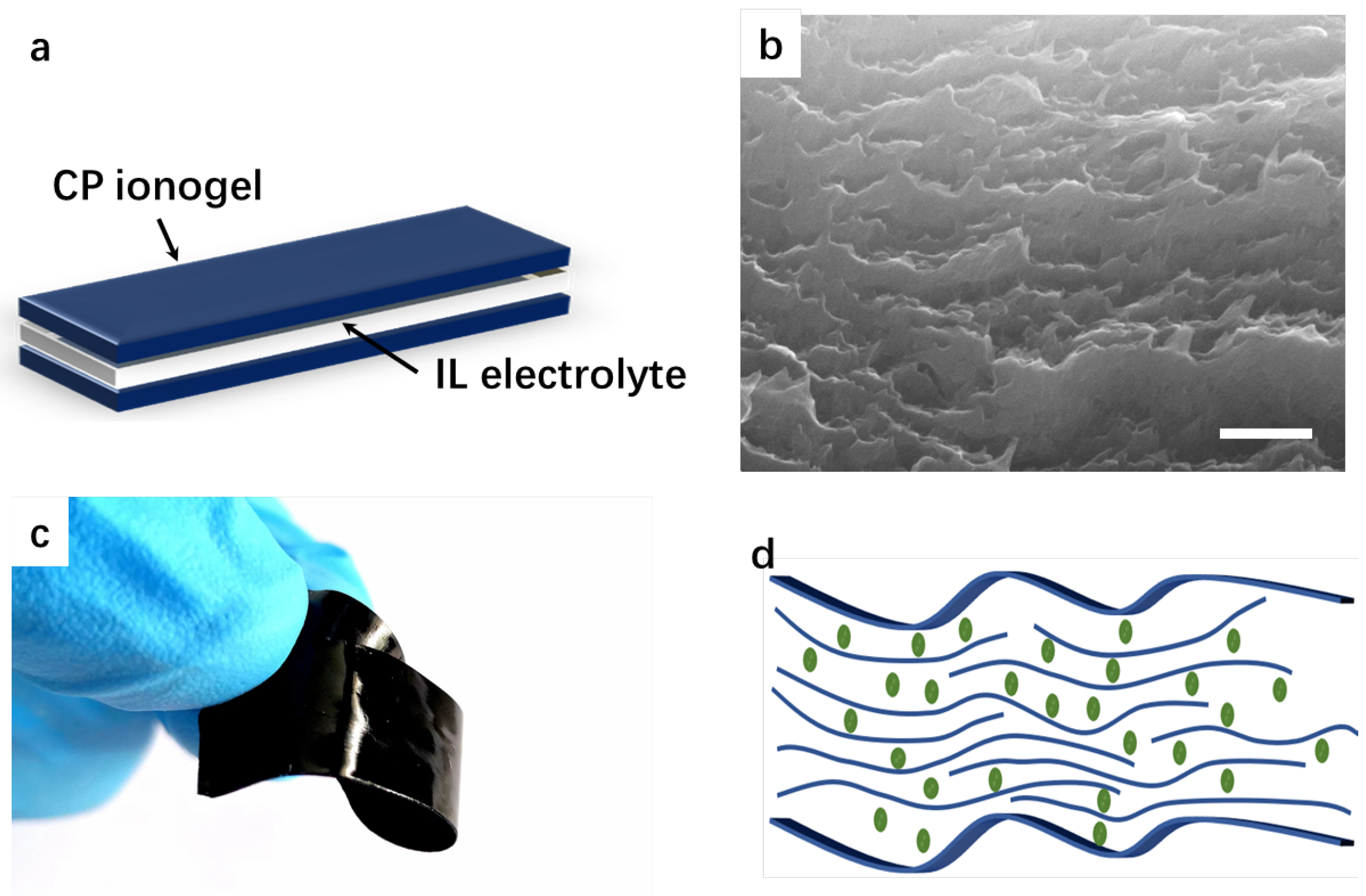
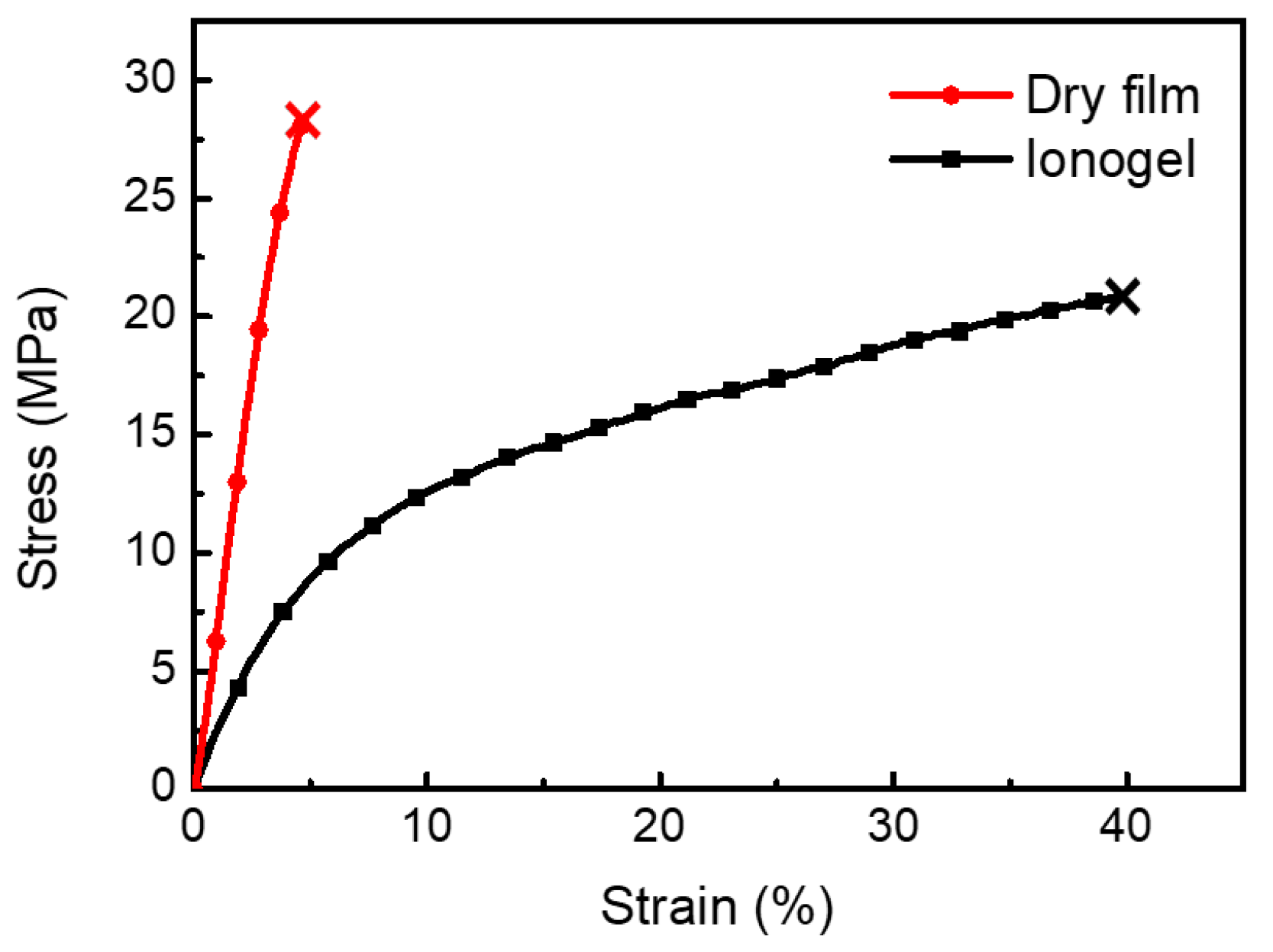

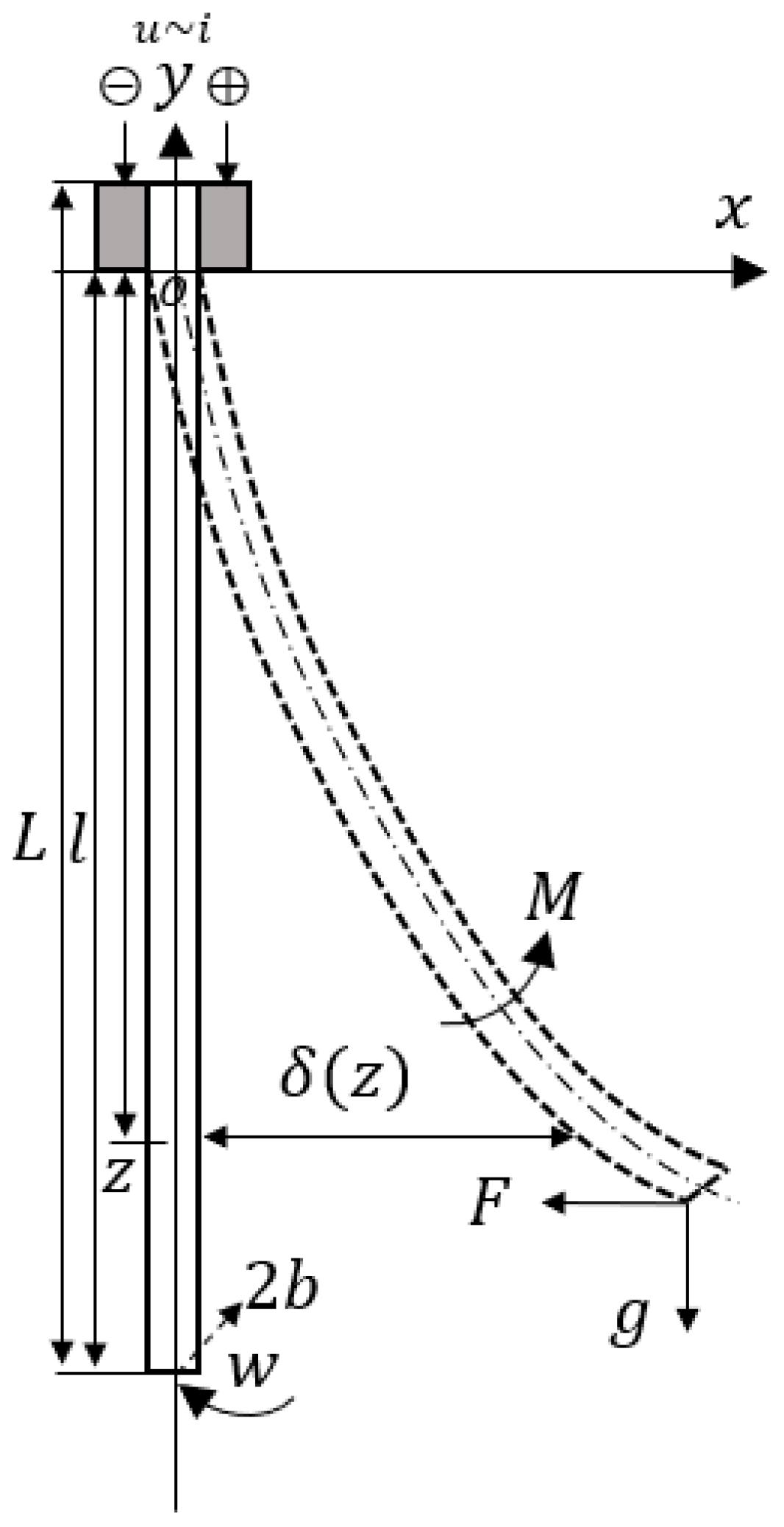


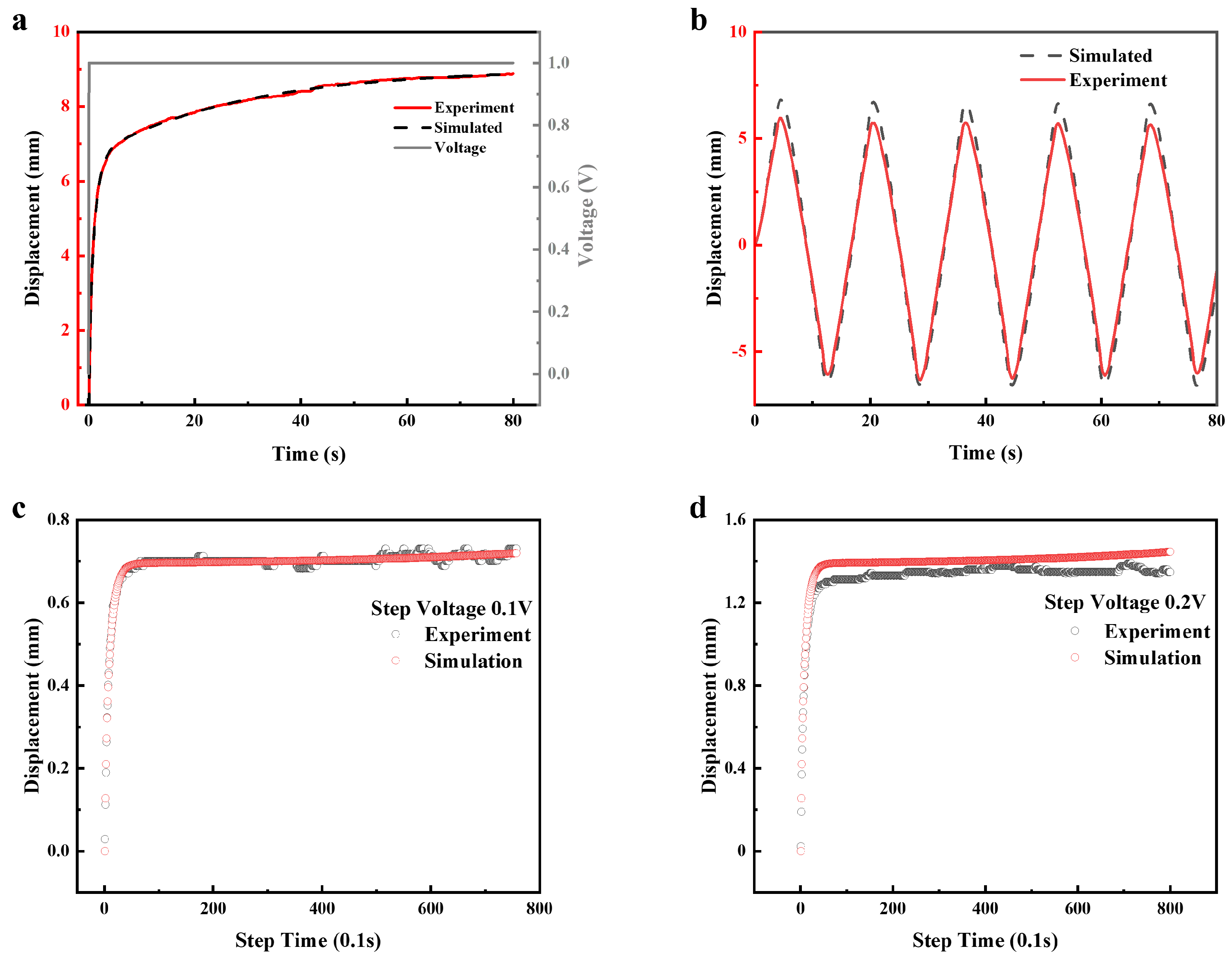

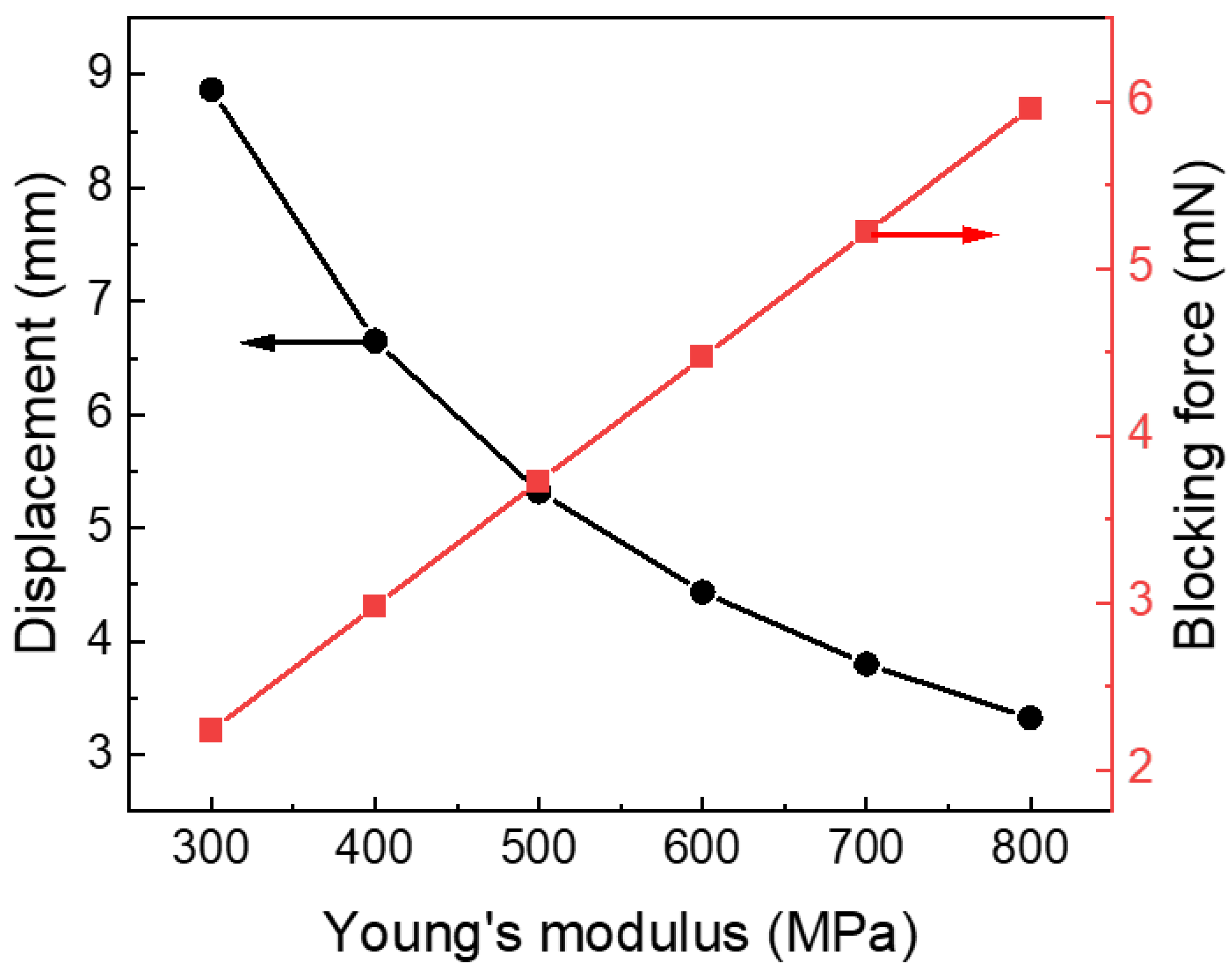
| Parameters | Meanings |
|---|---|
| L | Total Length |
| l | Free Length |
| z | Observation Point |
| F | Blocking Force |
| (z) | Displacement of Observation point |
| w | Width |
| b | Half Thickness |
| u | Control Voltage |
| i | Current |
| M | Induced Bending Moment caused by Ionic Migration |
| g | Gravity |
| Parameters | Values |
|---|---|
| 7 | |
| 0.01 F | |
| R | 10,000 |
| L | 20 mm |
| E | 300 MPa |
| w | 4.2 mm |
| z | 18 mm |
| b | 0.09 mm |
| 0.02 mm |
| Parameters | Values |
|---|---|
| k | 86.478 |
| p1 | 0.036 |
| p2 | 0.901 |
| z1 | 2.406 |
| z2 | 0.048 |
Disclaimer/Publisher’s Note: The statements, opinions and data contained in all publications are solely those of the individual author(s) and contributor(s) and not of MDPI and/or the editor(s). MDPI and/or the editor(s) disclaim responsibility for any injury to people or property resulting from any ideas, methods, instructions or products referred to in the content. |
© 2023 by the authors. Licensee MDPI, Basel, Switzerland. This article is an open access article distributed under the terms and conditions of the Creative Commons Attribution (CC BY) license (https://creativecommons.org/licenses/by/4.0/).
Share and Cite
Xu, J.; Hu, H.; Zhang, S.; Cheng, G.; Ding, J. Flexible Actuators Based on Conductive Polymer Ionogels and Their Electromechanical Modeling. Polymers 2023, 15, 4482. https://doi.org/10.3390/polym15234482
Xu J, Hu H, Zhang S, Cheng G, Ding J. Flexible Actuators Based on Conductive Polymer Ionogels and Their Electromechanical Modeling. Polymers. 2023; 15(23):4482. https://doi.org/10.3390/polym15234482
Chicago/Turabian StyleXu, Jiawei, Hongwei Hu, Shengtao Zhang, Guanggui Cheng, and Jianning Ding. 2023. "Flexible Actuators Based on Conductive Polymer Ionogels and Their Electromechanical Modeling" Polymers 15, no. 23: 4482. https://doi.org/10.3390/polym15234482
APA StyleXu, J., Hu, H., Zhang, S., Cheng, G., & Ding, J. (2023). Flexible Actuators Based on Conductive Polymer Ionogels and Their Electromechanical Modeling. Polymers, 15(23), 4482. https://doi.org/10.3390/polym15234482






